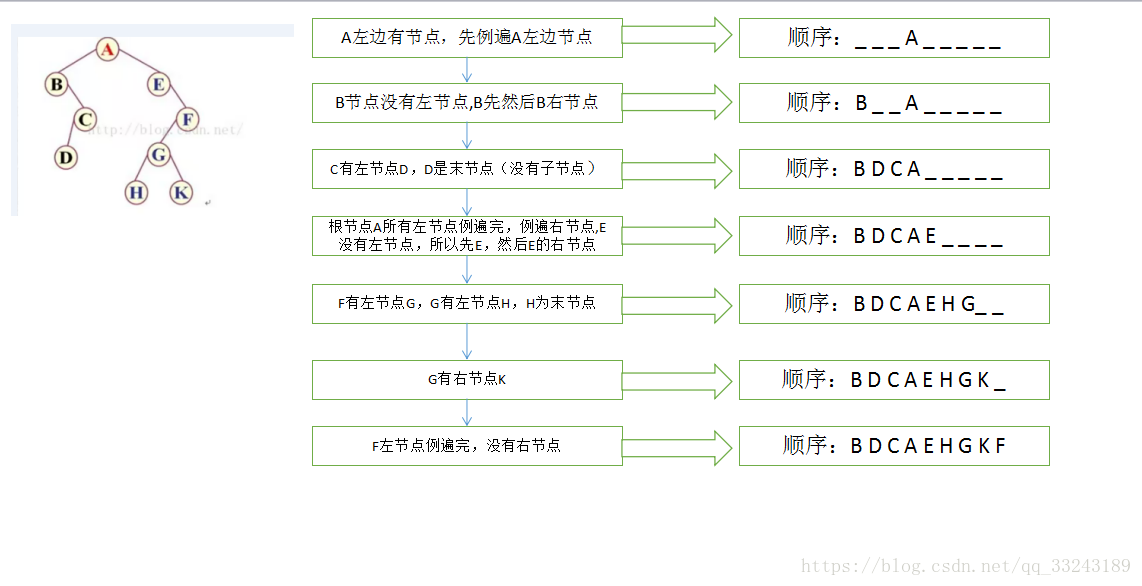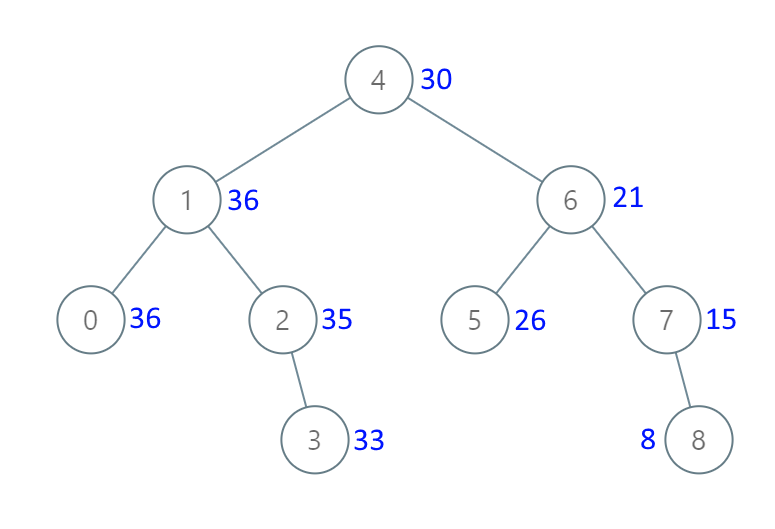数据结构和算法(五)树(二叉树、满二叉树、完全二叉树、二叉搜索树)
二叉树:
二叉树是每个结点最多有两个子树的树结构
满二叉树:
除最后一层无任何子节点外,每一层上的所有结点都有两个子结点的二叉树。
完全二叉树:
若设二叉树的深度为h,除第 h 层外,其它各层 (1~h-1) 的结点数都达到最大个数,第 h 层所有的结点都连续集中在最左边,这就是完全二叉树。
二叉搜索树:
满足“任意结点x,左子树结点值最大不超过x,右子树结点值最小不低于x” 的二叉树。
1、构建
public class Tree {
private int key; // 结点内容
private Tree left; // 左子结点
private Tree right; // 右子结点
private Tree parent; // 父结点
private Tree root; // 根结点
// 省略get/set
}
2、插入
通过遍历,找到父结点(从根结点开始),然后在设置是父的左子还是右子
private void insert(Tree tree) {
Tree x = this.root;
while (x != null) {
if (tree.key < x.key) {
if (x.left == null) {
break;
} else {
x = x.left;
}
} else {
if (x.right == null) {
break;
} else {
x = x.right;
}
}
}
tree.parent = x;
if (x == null) {
this.root = tree;
} else if (tree.key < x.key) {
x.left = tree;
} else {
x.right = tree;
}
}
3、最大值和最小值
根据二叉搜索树的概念,左子树的值小于右子树的值。所以,最小值就是:左子树的左子树的左子树…; 最大值就是右子树的右子树的右子树…
// 值最小的结点
private Tree minimum(Tree x) {
while (x.left != null) {
x = x.left;
}
return x;
}
// 值最大的结点
private Tree maximum(Tree x) {
while (x.right != null) {
x = x.right;
}
return x;
}
4、遍历
命名规则:按根结点输出的顺序
中序遍历:输出的子树根的值位于左子树的值和右子树的值之间
先序遍历:输出的根的值在左右子树的值之前
后序遍历:输出的根的值在左右子树的值之后
图解(中序遍历)[图片出处网络,侵删]:

中序遍历
private static void inorder(Tree x) {
if (x != null) {
inorder(x.left);
System.out.print(x.key + ", ");
inorder(x.right);
}
}
前序遍历
private static void preorder(Tree x) {
if (x != null) {
System.out.print(x.key + ", ");
preorder(x.left);
preorder(x.right);
}
}
后序遍历
private static void postorder(Tree x) {
if (x != null) {
postorder(x.left);
postorder(x.right);
System.out.print(x.key + ", ");
}
}
5、搜索
搜索比较简单,从树根开始查找,遇到结点,比较结点值和搜索的值,两值相等,搜索中止。如果查找的值小于结点的值,则查找的值在结点的左子树,继续在左子树重复上述查找动作。
private static Tree search(Tree x, int key) {
while (x != null && x.key != key) {
if (x.key > key) {
x = x.left;
} else {
x = x.right;
}
}
return x;
}
6、删除
设要删除的结点为z
(1)如果z没有孩子结点,用null替代z;
(2)如果z有且只有一个孩子结点,将孩子结点替代z;
(3)如果z有两个孩子结点。我们需要查找一个后继y,它需要满足以下两个条件:
a)y位于右子树中;
b)y没有左孩子;
如果y是z的右孩子,直接用y替换z,并留下y的右孩子。
如果y在z右子树,但不是右孩子。先用y的右孩子替换y,然后用y替换z。
private void delete(Tree z) {
if (z.left == null) {
transplant(z, z.right);
} else if (z.right == null) {
transplant(z, z.left);
} else {
Tree y = minimum(z.right);
if (y.parent != z) {
transplant(y, y.right);
y.right = z.right;
y.right.parent = y;
}
transplant(z, y);
y.left = z.left;
y.left.parent = y;
}
}
// 用v子树替代u子树
private void transplant(Tree u, Tree v) {
if (u.parent == null) {
this.root = v;
} else if (u == u.parent.left) {
u.parent.left = v;
} else {
u.parent.right = v;
}
if (v != null) {
v.parent = u.parent;
}
}
7、扩展(力扣1038 从二叉搜索树到更大和树)
如果您执行了上面的中序遍历代码,会发现中序输出是正序的(从小到大)。有正序就有倒序,我们改下代码,就成倒序了。
private static void inorder2(Tree x) {
if (x != null) {
inorder2(x.right);
System.out.print(x.key + ", ");
inorder2(x.left);
}
}
力扣上有一题,正好可以用到这个反向中序。
1038. 从二叉搜索树到更大和树
给出二叉搜索树的根节点,该二叉树的节点值各不相同,修改二叉树,使每个节点 node 的新值等于原树中大于或等于 node.val 的值之和。
示例:
输入:[4,1,6,0,2,5,7,null,null,null,3,null,null,null,8]
输出:[30,36,21,36,35,26,15,null,null,null,33,null,null,null,8]

解题:
/**
* Definition for a binary tree node.
* public class TreeNode {
* int val;
* TreeNode left;
* TreeNode right;
* TreeNode(int x) { val = x; }
* }
*/
class Solution {
private int sum = 0;
public TreeNode bstToGst(TreeNode root) {
if (root != null) {
bstToGst(root.right);
sum += root.val;
root.val = sum;
bstToGst(root.left);
}
return root;
}
}
[1] 《算法导论》 机械工业出版社
[2] 力扣(LeetCode)https://leetcode-cn.com/problems/binary-search-tree-to-greater-sum-tree